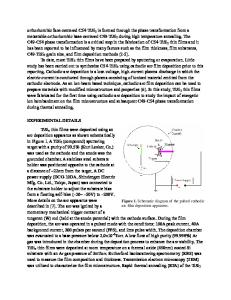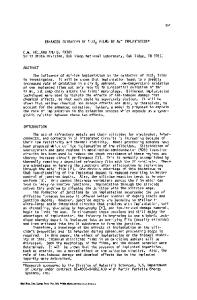Synthesis of Two-Layer TiB 2 -TiSi 2 Structures by Boron Implantation into Titanium Film and Rapid Thermal Annealing
- PDF / 292,005 Bytes
- 5 Pages / 420.48 x 639 pts Page_size
- 66 Downloads / 288 Views
SYNTHESIS OF TWO-LAYER TiB -TiSi 2 STRUCTURES BY BORON IMPLANTATION INTO TITANIUM FILM AND RAPID THERMAL ANNEALING V.V. Tokarev*, A.I. Demchenko*, A.I. Ivanov*, V.E. Borisenko**, and D.I. Zarovsky** *Institute of Solid State and Semiconductor Physics, the BSSR Academy of Sciences, P. Browka 17, 220726 Minsk, USSR **Minsk Radioengineering Institute, P. Browka 6, 220600 Minsk, USSR 1. INTRODUCTION Further progress in IC dimension reduction, increase in integration degree and speed require development and use of new current-conducting materials. This is due to the fact that existing current-conducting systems based on aluminium are low temperature, characterized by low electromi gration stability and require use of complex barrier layersi[l]. Polycide currentconducting materials have quite high resistance, interact with aluminium and are sensitive to the formation conditions. From this point of view, borides and titanium borides in particular are very promising for making current-conducting systems since they are very much characterized by good barrier properties, high conductance, properties and electromigration stabilityl2]. 2. EXPERIMENTAL This paper presents experimental results on synthesis of two-layer boride-titanium silicide structures by pulse heat treatment of boron-implanted titanium films on single-crystalline silicon. 80-300 nm titanium films were deposited onto chemically cleaned, n-type single-crystalline silicon (100) wafers usiig electron-beam evaporation at residual pressure of about 10Pa. The prepared structures were divided into two groups. The group were annealed at 250, 450, 650 and samples of the first 850 0 C for 30 min. The second group was not annealed. The samples werl then implanted with boron ions with doses of 1E161E18 cm-• and mean projected ranges of 50-100 nm using experimental ion implantation setup with ion beam integrated current of 10 mA. The temperature of the samples during implantation was kept at 50 0 C. The subsequent rapid thermal annealing (RTA) was performed in dried argon using halogen lamp intensive radiation under transient thermal balance conditions for 10-40 s at induced temperatures of 600-9000 C[3]. Diffusion processes occurring in the structures investigated were controlled by Auger electron spectroscopy (AES). Phase composition of the layers formed was analysed using xray diffraction analysis. 3. RESULTS AND DISCUSSION X-ray diffraction analysis and study of AES spectra of the samples after preliminary stationary heat treatment showed that heat treatment below 650 0 C didn't cause diffusion redistribution of titanium and silicon and silicide formation. Mat. Res. Soc. Symp. Proc. Vol. 128. c1989 Materials Research Society
654
Heat treatment at higher temperatures results in diffusion mixing of silicon and titanium. The resulting silicide layers consist mainly of titanium disilicide (TiSi 2 ) and metal-rich silicide (Ti 5 Si 3 ) inclusions (Fig. la).
I
t
Cl
at o850C -TL$ý2
200
, .6LA
20S
a[+0Tt
ALJ L 70
60
YO
40
2E
Fig. 1. X-ray diffraction patterns
Data Loading...









